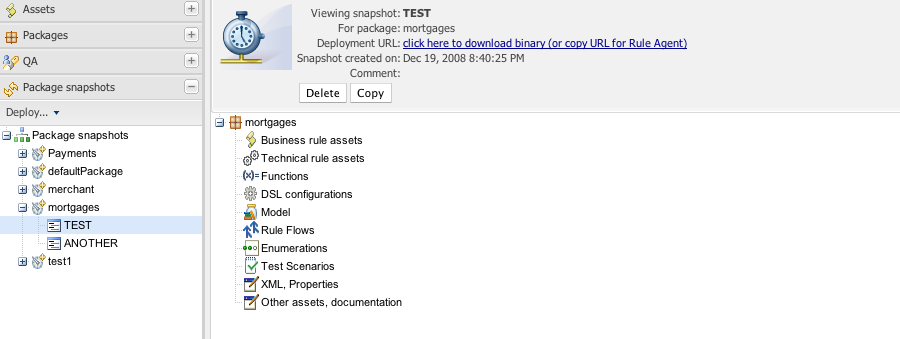Its all very interesting to manage rules, but how to you use or "consume" them in your application? This section covers the usage of the KnowledgeAgent deployment component that automates most of this for you.
The knowledge agent is a component which is embedded in knowledge-api. To use this, you don't need any extra components. In fact, if you are using Guvnor, your application should only need to include the knowledge-api and drools-core dependencies in its classpath (drools and mvel JARs only), and no other rules specific dependencies.
Note that there is also a drools-ant ant task, so you can build rules as part of an Ant script (for example in cases where the rules are edited in the IDE) without using Guvnor at all - the drools-ant task will generate .pkg files the same as Guvnor.
Once you have "built" your rules in a package in Guvnor (or from the ant task), you are ready to use the agent in your target application.
The Following example constructs an agent that will build a new KnowledgeBase from the files specified in the path String. It will poll those files every 60 seconds, which is the default, to see if they are updated. If new files are found it will construct a new KnowledgeBase. If the change set specifies a resource that is a directory it's contents will be scanned for changes too.
KnowledgeAgent kagent = KnowledgeAgentFactory.newKnowledgeAgent( "MyAgent" );
kagent.applyChangeSet( ResourceFactory.newUrlResource( url ) );
KnowledgeBase kbase = kagent.getKnowledgeBase();
The KnowledgeAgent can accept a configuration that allows for some of the defaults to be changed. An
example property is drools.agent.scanDirectories, by default any specified directories are
scanned for new additions, it is possible to disable this.
KnowledgeBase kbase = KnowledgeBaseFactory.newKnowledgeBase();
KnowledgeAgentConfiguration kaconf = KnowledgeAgentFactory.newKnowledgeAgentConfiguration();
// we do not want to scan directories, just files
kaconf.setProperty( "drools.agent.scanDirectories", "false" );
// the name of the agent
KnowledgeAgent kagent = KnowledgeAgentFactory.newKnowledgeAgent( "test agent", kaconf );
// resource to the change-set xml for the resources to add
kagent.applyChangeSet( ResourceFactory.newUrlResource( url ) );
An example of the change-set.xml file.
<change-set xmlns='http://drools.org/drools-5.0/change-set'";
xmlns:xs='http://www.w3.org/2001/XMLSchema-instance'
xs:schemaLocation='http://drools.org/drools-5.0/change-set drools-change-set-5.0.xsd' >
<add>
<resource source='http://localhost:9000/TEST.pkg' type='PKG' />
</add>
</change-set>
Resource scanning is not on by default, it's a service and must be started, the same is for notification. This can be done via the ResourceFactory.
ResourceFactory.getResourceChangeNotifierService().start();
ResourceFactory.getResourceChangeScannerService().start();
Following shows the deployment screen of Guvnor, which provides URLs and downloads of packages.
You can see the "Package URI" - this is the URL that you would copy and paste into the
change-set.xml file to specify that you want this package. It specifies an exact
version (in this case to a snapshot) - each snapshot has its own URL. If you want the "latest" - then
replace "NewSnapshot" with "LATEST".
You can also download a .pkg file from here, which you can drop in a directory and use the "file" or "dir" feature of the KnowledgeAgent if needed (in some cases people will not want to have the runtime automatically contact Guvnor for updates - but that is generally the easiest way for many people).
